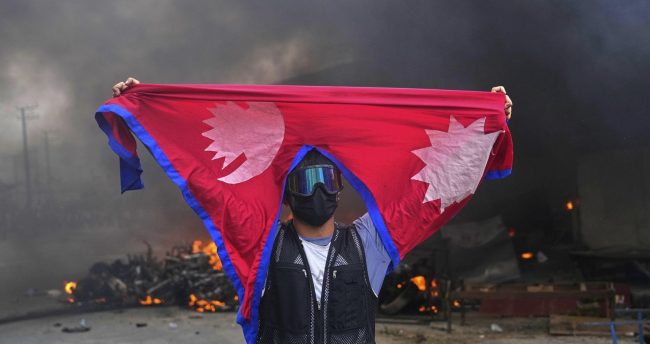Opinion Nepal’s Gen-Z revolt: Remittances, rage, and the price of political stagnation
The real tragedy would be if Nepal’s Gen-Z, like their Sri Lankan and Bangladeshi counterparts, discovers that the old order retains an uncanny ability to ride even the wildest wave of youthful rage
 Nepal today is a theatre of intergenerational confrontation. The youth have spoken, clearly and loudly
Nepal today is a theatre of intergenerational confrontation. The youth have spoken, clearly and loudly Written by Vaishu Rai
When a generation armed with smartphones but constrained by shrinking domestic opportunities takes to the streets, it is tempting to dismiss the mobilisation as a fleeting hashtag-storm. In Nepal today, that would be a serious misreading. The protests that erupted in early September, led largely by teenagers and twenty-somethings, were triggered by a temporary government ban on social media. Branded Nepal’s “Gen-Z revolution,” the label captures more than digital dissent.
The spark may have been online censorship, but years of corruption, nepotism, and economic precarity laid the tinder. Outrage over privileged “nepo-kids” flaunting wealth on TikTok and Instagram resonated with Nepalis whose futures are circumscribed by limited domestic opportunities. The unrest claimed at least 19 lives and injured hundreds, forcing Prime Minister K P Sharma Oli to resign. Security forces were deployed across Kathmandu, while discussions over an interim administration, potentially led by former Chief Justice Sushila Karki, dominate both street and institutional discourse.
Remittances and Economic Frustration
A critical driver of the revolt is Nepal’s reliance on remittances. In 2024, Nepalis working abroad sent home roughly $14.1 billion, up from $10.4 billion in 2023. While these inflows sustain households, they highlight a generational dilemma: Domestic economic prospects remain tied to precarious overseas work, even as political elites consolidate wealth at home. Remittances constitute over 25–30 per cent of Nepal’s GDP, reflecting a structural dependency that fuels cynicism toward a political class that cycles through Kathmandu while outsourcing livelihoods to Qatar, Malaysia, and beyond.
Historical Roots of Instability
Nepal’s instability has deep roots. The Maoist insurgency (1996–2006) led to the 2006 Comprehensive Peace Accord, the abolition of the Shah monarchy in 2008, and the establishment of a federal democratic republic. The 2015 constitution codified these changes. Yet since 2008, Nepal has witnessed more than a dozen governments, frequent coalition shifts, and recurrent crises. The Communist Party of Nepal (Unified Marxist-Leninist – CPN-UML), long led by Oli, remains dominant alongside the Nepali Congress, Maoist-origin parties, and emerging youth-led civic collectives such as Hami Nepal.
The Gen-Z revolt mirrors wider South Asian patterns. Sri Lanka’s 2022 Aragalaya protests, triggered by economic collapse, ousted the Rajapaksa family. In 2024, Bangladeshi students mobilised over civil-service quotas, expanding their protests to violent crackdowns and regime change. These cases illustrate the fragility of political institutions when governments fail to cultivate intergenerational trust, leaving youth to challenge governance directly.
Political Uncertainty and the Interim Administration
So far, no interim consensus has emerged. Civil-society groups have proposed former Chief Justice Karki as a neutral figure acceptable to both street protesters and institutional actors. Her candidature has received support from Balen Shah, the rapper-turned-mayor of Kathmandu, whose rise symbolises the new generation’s demand for accountability and a break from traditional party politics. Other emerging names include Harka Sampang and Sumana Shrestha. Alternatives under discussion include caretaker technocrats or coalition compromises. Yet with army deployments, fluid street politics, and entrenched party interests, an immediate resolution remains uncertain. Negotiations between the presidency, the CPN-UML, Nepali Congress, Maoist factions, and the military are expected to dominate the coming weeks.
Alleged involvement of Rabi Lamichhane’s Rastriya Swatantra Party (RSP) and the Maoist Centre, led by Pushpa Kamal Dahal “Prachanda,” has raised concerns about co-optation of the movement by political actors.
Nepal’s Gen-Z revolt carries lessons beyond its borders. Democracies in the region risk destabilisation when political elites fail to build intergenerational trust. Youth-led movements can rapidly challenge governance when economic grievances, visible elite privilege, and political stagnation converge. Censorship and coercion may suppress dissent temporarily, but without credible pathways for youth inclusion, accountability, and trust, democratic institutions remain fragile.
Short- and Medium-Term Outlook
In the short term, Nepal faces continued unrest, security clampdowns, and economic disruption affecting tourism, trade, and remittance flows. Medium-term solutions may include a neutral interim administration and transparent electoral timelines, potentially enabling reforms such as stronger social-media governance, reduced elite capture, and enhanced transparency. Yet political fragmentation and entrenched patronage networks may limit meaningful change.
Nepal is not merely a “small-country” theatre of unrest. As a young republic with a constitution barely a decade old, its institutions are still forming — vulnerable yet flexible. Key questions persist: Will Karki, if appointed, act as a genuine interim guardian or a ceremonial bridge to another cycle of elite politics? Will figures like Balen Shah, Kathmandu’s rapper-turned-mayor, emerge as authentic voices for this generation, or be sidelined by party machinery?
Nepal today is a theatre of intergenerational confrontation. The youth have spoken, clearly and loudly. Revolutions are seldom resolved through resignation letters alone; they endure or falter in the quieter, arduous work of institutions, elections, and vigilance against co-optation. The real tragedy would be if Nepal’s Gen-Z, like their Sri Lankan and Bangladeshi counterparts, discovers that the old order retains an uncanny ability to ride even the wildest wave of youthful rage.
The writer is Legislative and Policy Researcher and LAMP Fellow (2024–25) at PRS Legislative





